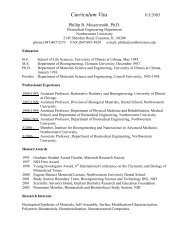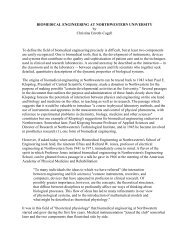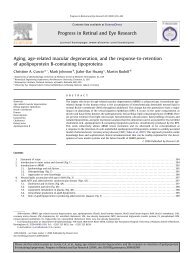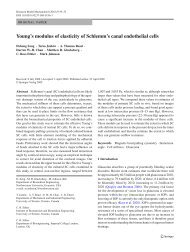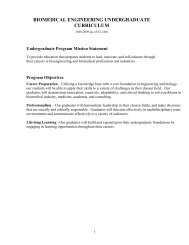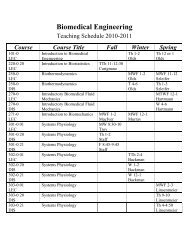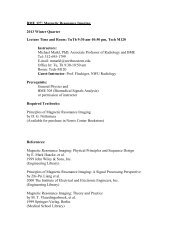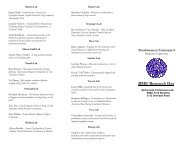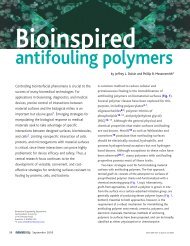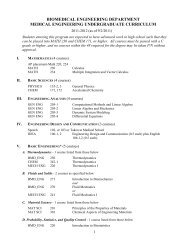Computation of tightly-focused laser beams in the FDTD method
Computation of tightly-focused laser beams in the FDTD method
Computation of tightly-focused laser beams in the FDTD method
You also want an ePaper? Increase the reach of your titles
YUMPU automatically turns print PDFs into web optimized ePapers that Google loves.
<strong>Computation</strong> <strong>of</strong> <strong>tightly</strong>-<strong>focused</strong> <strong>laser</strong><br />
<strong>beams</strong> <strong>in</strong> <strong>the</strong> <strong>FDTD</strong> <strong>method</strong><br />
İlker R. Çapoğlu, 1∗ Allen Taflove, 2 and Vadim Backman 1<br />
1 Biomedical Eng<strong>in</strong>eer<strong>in</strong>g Department, Northwestern University<br />
2145 Sheridan Road, Evanston, IL, USA 60208<br />
2 Electrical Eng<strong>in</strong>eer<strong>in</strong>g and Computer Science Department, Northwestern University<br />
2145 Sheridan Road, Evanston, IL, USA 60208<br />
∗ capoglu@ieee.org<br />
Abstract: We demonstrate how a <strong>tightly</strong>-<strong>focused</strong> coherent TEM mn<br />
<strong>laser</strong> beam can be computed <strong>in</strong> <strong>the</strong> f<strong>in</strong>ite-difference time-doma<strong>in</strong> (<strong>FDTD</strong>)<br />
<strong>method</strong>. The electromagnetic field around <strong>the</strong> focus is decomposed <strong>in</strong>to<br />
a plane-wave spectrum, and approximated by a f<strong>in</strong>ite number <strong>of</strong> plane<br />
waves <strong>in</strong>jected <strong>in</strong>to <strong>the</strong> <strong>FDTD</strong> grid us<strong>in</strong>g <strong>the</strong> total-field/scattered-field<br />
(TF/SF) <strong>method</strong>. We provide an error analysis, and guidel<strong>in</strong>es for <strong>the</strong><br />
discrete approximation. We analyze <strong>the</strong> scatter<strong>in</strong>g <strong>of</strong> <strong>the</strong> beam from layered<br />
spaces and <strong>in</strong>dividual scatterers. The described <strong>method</strong> should be useful<br />
for <strong>the</strong> simulation <strong>of</strong> confocal microscopy and optical data storage. An<br />
implementation <strong>of</strong> <strong>the</strong> <strong>method</strong> can be found <strong>in</strong> our free and open source<br />
<strong>FDTD</strong> s<strong>of</strong>tware (“Angora”).<br />
© 2013 Optical Society <strong>of</strong> America<br />
OCIS codes: (050.1755) <strong>Computation</strong>al electromagnetic <strong>method</strong>s; (000.4430) Numerical approximation<br />
and analysis; (180.1790) Confocal microscopy; (210.0210) Optical data storage.<br />
References and l<strong>in</strong>ks<br />
1. A. Taflove and S. C. Hagness, <strong>Computation</strong>al Electrodynamics: The F<strong>in</strong>ite-Difference Time-Doma<strong>in</strong> Method<br />
(Artech House, Boston, 2005), 3rd ed.<br />
2. W. Sun, S. Pan, and Y. Jiang, “<strong>Computation</strong> <strong>of</strong> <strong>the</strong> optical trapp<strong>in</strong>g force on small particles illum<strong>in</strong>ated with a<br />
<strong>focused</strong> light beam us<strong>in</strong>g a <strong>FDTD</strong> <strong>method</strong>,” J. Mod. Opt. 2691–2700 (2006).<br />
3. I. R. Capoglu, A. Taflove, and V. Backman, “Generation <strong>of</strong> an <strong>in</strong>cident <strong>focused</strong> light pulse <strong>in</strong> <strong>FDTD</strong>,” Opt.<br />
Express 16, 19208–19220 (2008).<br />
4. L. Jia and E. L. Thomas, “Radiation forces on dielectric and absorb<strong>in</strong>g particles studied via <strong>the</strong> f<strong>in</strong>ite-difference<br />
time-doma<strong>in</strong> <strong>method</strong>,” J. Opt. Soc. Am. B Opt. Phys. 26, 1882–1891 (2009).<br />
5. J. L<strong>in</strong>, F. Lu, H. Wang, W. Zheng, C. J. R. Sheppard, and Z. Huang, “Improved contrast radially polarized<br />
coherent anti-Stokes Raman scatter<strong>in</strong>g microscopy us<strong>in</strong>g annular aperture detection,” Appl. Phys. Lett. 95 (2009).<br />
6. C. Guiffaut and K. Mahdjoubi, “A perfect wideband plane wave <strong>in</strong>jector for <strong>FDTD</strong> <strong>method</strong>,” <strong>in</strong> “Antennas and<br />
Propagation Society International Symposium, 2000. IEEE,” , (Salt Lake City, UT, USA, 2000), 1, 236–239.<br />
7. T. Tan and M. Potter, “<strong>FDTD</strong> discrete planewave (<strong>FDTD</strong>-DPW) formulation for a perfectly matched source <strong>in</strong><br />
TFSF simulations,” IEEE Trans. Antennas Propag. 58, 2641–2648 (2010).<br />
8. L. Mandel and E. Wolf, Optical Coherence and Quantum Optics (Cambridge University Press, 1995).<br />
9. M. Abramowitz and I. A. Stegun, eds., Handbook <strong>of</strong> Ma<strong>the</strong>matical Functions with Formulas, Graphs, and Ma<strong>the</strong>matical<br />
Tables (U.S. Govt. Pr<strong>in</strong>t. Off., 1964).<br />
10. J. W. Goodman, Statistical Optics (Wiley, New York, NY, 2000).<br />
11. M. Born and E. Wolf, Pr<strong>in</strong>ciples <strong>of</strong> Optics : Electromagnetic Theory <strong>of</strong> Propagation, Interference and Diffraction<br />
<strong>of</strong> Light (Cambridge University Press, Cambridge, 1999), 7th ed.<br />
12. L. Novotny and B. Hecht, Pr<strong>in</strong>ciples <strong>of</strong> Nano-optics (Cambridge University Press, 2006).<br />
13. B. Richards and E. Wolf, “Electromagnetic diffraction <strong>in</strong> optical systems. II. Structure <strong>of</strong> <strong>the</strong> image field <strong>in</strong> an<br />
aplanatic system,” Proc. R. Soc. Lond. A Math. Phys. Sci. 253, 358–379 (1959).<br />
14. E. Wolf, “Electromagnetic diffraction <strong>in</strong> optical systems. I. An <strong>in</strong>tegral representation <strong>of</strong> <strong>the</strong> image field,” Proc.<br />
R. Soc. Lond. A Math. Phys. Sci. 253, 349–357 (1959).<br />
#177620 - $15.00 USD Received 8 Oct 2012; revised 2 Dec 2012; accepted 3 Dec 2012; published 2 Jan 2013<br />
(C) 2013 OSA 14 January 2013 / Vol. 21, No. 1 / OPTICS EXPRESS 87
15. M. Born and E. Wolf, Pr<strong>in</strong>ciples <strong>of</strong> Optics (Cambridge University Press, Cambridge, 1999), 7th ed.<br />
16. R. Cools and K. Kim, “A survey <strong>of</strong> known and new cubature formulas for <strong>the</strong> unit disk,” J. Appl. Math. Comput.<br />
7, 477–485 (2000).<br />
17. R. Cools and P. Rab<strong>in</strong>owitz, “Monomial cubature rules s<strong>in</strong>ce Stroud: A compilation,” J. Comput. Appl. Math.<br />
48, 309–326 (1993).<br />
18. R. Cools, “Monomial cubature rules s<strong>in</strong>ce Stroud: A compilation - part 2,” J. Comput. Appl. Math. 112, 21–27<br />
(1999).<br />
19. R. Cools, “An encyclopaedia <strong>of</strong> cubature formulas,” J. Complexity 19, 445–453 (2003).<br />
20. L. E. R. Petersson and G. S. Smith, “On <strong>the</strong> use <strong>of</strong> a Gaussian beam to isolate <strong>the</strong> edge scatter<strong>in</strong>g from a plate <strong>of</strong><br />
f<strong>in</strong>ite size,” IEEE Trans. Antennas Propag. 52, 505–512 (2004).<br />
21. W. H. Press, B. P. Flannery, S. A. Teukolsky, and W. T. Vetterl<strong>in</strong>g, Numerical Recipes: The Art <strong>of</strong> Scientific<br />
Comput<strong>in</strong>g (Cambridge University Press, Cambridge, 1986).<br />
22. R. Cools, “Encyclopaedia <strong>of</strong> Cubature Formulas,” (2012). http://n<strong>in</strong>es.cs.kuleuven.be/ecf.<br />
23. L. Novotny, Private communication.<br />
24. I. R. Capoglu and G. S. Smith, “A total-field/scattered-field plane-wave source for <strong>the</strong> <strong>FDTD</strong> analysis <strong>of</strong> layered<br />
media,” IEEE Trans. Antennas Propag. 56, 158–169 (2008).<br />
25. I. R. Capoglu, A. Taflove, and V. Backman, “A frequency-doma<strong>in</strong> near-field-to-far-field transform for planar<br />
layered media,” IEEE Trans. Antennas Propag. 60, 1878–1885 (2012).<br />
26. J. A. Roden and S. D. Gedney, “Convolution PML (CPML): an efficient <strong>FDTD</strong> implementation <strong>of</strong> <strong>the</strong> CFD-PML<br />
for arbitrary media,” Microw. Opt. Technol. Lett. 27, 334–9 (2000).<br />
27. I. R. Capoglu, J. D. Rogers, A. Taflove, and V. Backman, “Chapter 1 - The Microscope <strong>in</strong> a Computer: Image<br />
Syn<strong>the</strong>sis from Three-Dimensional Full-Vector Solutions <strong>of</strong> Maxwell’s Equations at <strong>the</strong> Nanometer Scale,” <strong>in</strong><br />
Progress <strong>in</strong> Optics, E. Wolf, ed. (Elsevier, 2012), 57, 1–91.<br />
28. I. R. Capoglu, “Angora: A free s<strong>of</strong>tware package for f<strong>in</strong>ite-difference time-doma<strong>in</strong> (<strong>FDTD</strong>) electromagnetic<br />
simulation,” (2012). http://www.angorafdtd.org.<br />
29. I. R. Capoglu, A. Taflove, and V. Backman, “Angora: A free s<strong>of</strong>tware package for f<strong>in</strong>ite-difference time-doma<strong>in</strong><br />
electromagnetic simulation,” accepted for publication <strong>in</strong> <strong>the</strong> IEEE Antennas and Propagation Magaz<strong>in</strong>e.<br />
30. I. R. Capoglu, “B<strong>in</strong>aries and configuration files used for <strong>the</strong> manuscript “<strong>Computation</strong> <strong>of</strong> <strong>tightly</strong>-<strong>focused</strong> <strong>laser</strong><br />
<strong>beams</strong> <strong>in</strong> <strong>the</strong> <strong>FDTD</strong> <strong>method</strong>”,” (2012). http://www.angorafdtd.org/ext/tflb/.<br />
1. Introduction<br />
The f<strong>in</strong>ite-difference time-doma<strong>in</strong> (<strong>FDTD</strong>) numerical electromagnetic <strong>method</strong> [1] is ga<strong>in</strong><strong>in</strong>g<br />
<strong>in</strong>creas<strong>in</strong>g popularity for solv<strong>in</strong>g nano-photonics problems [2–5]. In <strong>the</strong> <strong>FDTD</strong> <strong>method</strong>, <strong>the</strong><br />
electromagnetic field is def<strong>in</strong>ed at a f<strong>in</strong>ite number <strong>of</strong> discrete spatial positions, and calculated<br />
at consecutive discrete time <strong>in</strong>stants us<strong>in</strong>g an explicit leapfrogg<strong>in</strong>g algorithm. The simplest<br />
illum<strong>in</strong>ation modality <strong>in</strong> <strong>the</strong> <strong>FDTD</strong> <strong>method</strong> is <strong>the</strong> plane wave, which is now a standard feature <strong>in</strong><br />
most <strong>FDTD</strong> implementations. However, <strong>in</strong> many optical situations one needs to simulate a more<br />
complicated illum<strong>in</strong>ation beam. In this paper, we describe how a transverse-electric-magnetic<br />
(TEM) <strong>laser</strong> mode <strong>of</strong> order (m,n) <strong>focused</strong> by a lens can be simulated <strong>in</strong> <strong>the</strong> <strong>FDTD</strong> <strong>method</strong>.<br />
The basis <strong>of</strong> our technique is <strong>the</strong> decomposition <strong>of</strong> <strong>the</strong> beam around <strong>the</strong> focus <strong>in</strong>to a planewave<br />
spectrum, and <strong>the</strong> representation <strong>of</strong> this <strong>in</strong>f<strong>in</strong>ite sum by a f<strong>in</strong>ite number <strong>of</strong> plane waves<br />
with suitable amplitude factors. Each plane wave is <strong>in</strong>troduced <strong>in</strong>to <strong>the</strong> <strong>FDTD</strong> computational<br />
grid us<strong>in</strong>g <strong>the</strong> total-field/scattered-field (TF/SF) <strong>method</strong>, which is well-studied <strong>in</strong> <strong>the</strong> literature.<br />
The traditional TF/SF approach for <strong>in</strong>ject<strong>in</strong>g a plane wave <strong>in</strong>to <strong>the</strong> <strong>FDTD</strong> grid, expla<strong>in</strong>ed <strong>in</strong><br />
detail <strong>in</strong> [1], has s<strong>in</strong>ce been ref<strong>in</strong>ed by numerous authors. Two notable improvements to <strong>the</strong><br />
TF/SF <strong>method</strong> are <strong>the</strong> matched-numerical-dispersion <strong>method</strong> [6] and <strong>the</strong> perfectly-matched<br />
plane-wave source <strong>method</strong> [7].<br />
The approach described <strong>in</strong> this paper is similar to that followed <strong>in</strong> our previous work [3], with<br />
<strong>the</strong> follow<strong>in</strong>g improvements: (i) The range <strong>of</strong> <strong>beams</strong> that can be <strong>in</strong>troduced <strong>in</strong>to <strong>the</strong> <strong>FDTD</strong> grid<br />
is significantly expanded. The results <strong>in</strong> [3] merely correspond to <strong>the</strong> (0,0) mode with f 0 = ∞<br />
with<strong>in</strong> <strong>the</strong> context <strong>of</strong> <strong>the</strong> present paper. (ii) The <strong>focused</strong> beam is computed <strong>in</strong> spaces with planar<br />
layers and <strong>in</strong>homogeneities. A microscopy example is given to demonstrate <strong>the</strong> possibility for<br />
simulat<strong>in</strong>g a confocal imag<strong>in</strong>g scenario. (iii) The error analysis performed <strong>in</strong> <strong>the</strong> present paper is<br />
much more comprehensive and general. (iv) The results described here have been implemented<br />
#177620 - $15.00 USD Received 8 Oct 2012; revised 2 Dec 2012; accepted 3 Dec 2012; published 2 Jan 2013<br />
(C) 2013 OSA 14 January 2013 / Vol. 21, No. 1 / OPTICS EXPRESS 88
<strong>in</strong> an open-source <strong>FDTD</strong> s<strong>of</strong>tware (Angora), which can be freely downloaded under <strong>the</strong> GNU<br />
Public License.<br />
The rest <strong>of</strong> <strong>the</strong> paper is organized as follows. In Section 2, <strong>the</strong> <strong>the</strong>ory <strong>of</strong> <strong>the</strong> <strong>focused</strong> <strong>laser</strong><br />
beam is expla<strong>in</strong>ed. In Section 3, <strong>the</strong> <strong>FDTD</strong> computation <strong>of</strong> <strong>the</strong> <strong>the</strong>oretical results <strong>in</strong> Section<br />
2 are given. In Section 4, a comparative error analysis is presented for various approximation<br />
schemes. In Section 5, planar layered spaces and scatterers are discussed, and <strong>the</strong> capability for<br />
simulat<strong>in</strong>g confocal microscopy is demonstrated. In Section 6, future directions are discussed.<br />
In Section 7, our free, open-source <strong>FDTD</strong> s<strong>of</strong>tware (Angora) is briefly <strong>in</strong>troduced. The paper is<br />
concluded by f<strong>in</strong>al remarks <strong>in</strong> Section 8.<br />
2. Focus<strong>in</strong>g <strong>of</strong> <strong>laser</strong> <strong>beams</strong><br />
The transverse-electric-magnetic <strong>laser</strong> mode <strong>of</strong> order (m,n) (also called a Hermite-Gaussian<br />
mode, or a TEM mn mode) is a solution <strong>of</strong> <strong>the</strong> paraxial wave equation [8], which assumes that<br />
<strong>the</strong> energy <strong>in</strong> <strong>the</strong> beam propagates ma<strong>in</strong>ly <strong>in</strong> a s<strong>in</strong>gle direction along parallel rays. The electric<br />
field <strong>of</strong> a TEM mn mode at <strong>the</strong> beam waist, which is assumed to lie <strong>in</strong> <strong>the</strong> (x,y) plane, is given<br />
by <strong>the</strong> follow<strong>in</strong>g expression:<br />
E <strong>in</strong>c (x,y;t)=ê ψ(t)γ mn (x,y)=ê ψ(t)H m ( √ 2x/w 0 )H n ( √ 2y/w 0 )e −(x2 +y 2 )/w 2 0 , (1)<br />
where ê is <strong>the</strong> constant transverse unit vector <strong>in</strong> <strong>the</strong> (x,y) plane that determ<strong>in</strong>es <strong>the</strong> uniform polarization,<br />
ψ(t) is <strong>the</strong> time waveform <strong>of</strong> <strong>the</strong> beam, w 0 is <strong>the</strong> beam width, and H n (x) are <strong>the</strong> n th -<br />
order Hermite polynomials [9]. The first two Hermite polynomials are H 0 (x)=1, H 1 (x)=2x.<br />
The <strong>in</strong>tensity maps <strong>of</strong> <strong>the</strong> <strong>the</strong> time-<strong>in</strong>dependent parts <strong>of</strong> <strong>the</strong> (0,0), (0,1), (1,0), and (1,1)<br />
modes on <strong>the</strong> beam waist are shown <strong>in</strong> Fig. 1(a). In real situations, <strong>the</strong> time dependence ψ(t)<br />
is a randomly-fluctuat<strong>in</strong>g waveform; which can be assumed statistically stationary <strong>in</strong> time [8].<br />
This random process will have a wavelength spectrum, which might consist merely <strong>of</strong> a very<br />
narrow wavelength band for a traditional <strong>laser</strong>, or span a wide range <strong>of</strong> wavelengths for a supercont<strong>in</strong>uum<br />
<strong>laser</strong>. If <strong>the</strong> entire optical system (<strong>in</strong>clud<strong>in</strong>g <strong>the</strong> illum<strong>in</strong>ated object) is l<strong>in</strong>ear and<br />
time <strong>in</strong>variant, all second-order coherence properties at <strong>the</strong> output (e.g., power-spectral density<br />
at a po<strong>in</strong>t, mutual coherence function between two po<strong>in</strong>ts, etc.) are completely determ<strong>in</strong>ed by<br />
<strong>the</strong> second-order coherence properties <strong>of</strong> <strong>the</strong> <strong>in</strong>put waveform and <strong>the</strong> determ<strong>in</strong>istic spectral response<br />
<strong>of</strong> <strong>the</strong> system [8,10,11]. The latter can be obta<strong>in</strong>ed by send<strong>in</strong>g a determ<strong>in</strong>istic time pulse<br />
with a f<strong>in</strong>ite duration and a predef<strong>in</strong>ed spectral content through <strong>the</strong> system. The parameters <strong>of</strong><br />
a modulated Gaussian waveform, for example, can easily be adjusted to manipulate its spectral<br />
content; s<strong>in</strong>ce <strong>the</strong> cut<strong>of</strong>f wavelengths <strong>of</strong> this waveform are expressible <strong>in</strong> closed form. This is a<br />
suitable approach for a determ<strong>in</strong>istic numerical <strong>method</strong> such as <strong>FDTD</strong> that operates directly <strong>in</strong><br />
time doma<strong>in</strong>.<br />
If <strong>the</strong> maximum appreciable free-space wavelength λ max present <strong>in</strong> <strong>the</strong> spectrum <strong>of</strong> ψ(t) is<br />
much smaller than <strong>the</strong> beam waist w 0 , <strong>the</strong> paraxial approximation becomes valid, and <strong>the</strong> rays <strong>in</strong><br />
<strong>the</strong> beam stay mostly parallel to <strong>the</strong> z axis beyond <strong>the</strong> beam waist for many beam widths [12].<br />
We assume that such a highly-paraxial beam is <strong>in</strong>cident on <strong>the</strong> entrance pupil <strong>of</strong> a positive<br />
(convergent) optical system, as shown <strong>in</strong> Fig. 1(b). The focus<strong>in</strong>g system is assumed to be free<br />
<strong>of</strong> spherical aberration and obey<strong>in</strong>g <strong>the</strong> Abbe s<strong>in</strong>e condition. In o<strong>the</strong>r words, all parallel rays<br />
enter<strong>in</strong>g <strong>the</strong> entrance pupil are <strong>focused</strong> at <strong>the</strong> back focal po<strong>in</strong>t F, and a = f s<strong>in</strong>θ ill ; where a<br />
is <strong>the</strong> radius <strong>of</strong> <strong>the</strong> pupil, f is <strong>the</strong> back focal length <strong>of</strong> <strong>the</strong> system, and θ ill is <strong>the</strong> illum<strong>in</strong>ation<br />
aperture angle. A portion <strong>of</strong> <strong>the</strong> Gaussian reference sphere around F is shown shaded <strong>in</strong> Fig.<br />
1(b). The object and image spaces <strong>of</strong> <strong>the</strong> focus<strong>in</strong>g system are non-magnetic (μ 1 =μ 2 =1) with<br />
refractive <strong>in</strong>dices n 1 and n 2 , respectively. An example ray converg<strong>in</strong>g toward F is shown <strong>in</strong> Fig.<br />
1(b). The ray makes an angle θ with <strong>the</strong> optical axis at F. In <strong>the</strong> geometrical optics regime, <strong>the</strong><br />
#177620 - $15.00 USD Received 8 Oct 2012; revised 2 Dec 2012; accepted 3 Dec 2012; published 2 Jan 2013<br />
(C) 2013 OSA 14 January 2013 / Vol. 21, No. 1 / OPTICS EXPRESS 89
(a)<br />
(b)<br />
Fig. 1. (a) Intensity maps <strong>of</strong> several TEM mn modes on <strong>the</strong> beam waist. (b) The geometry<br />
<strong>of</strong> <strong>the</strong> <strong>in</strong>cidence and focus<strong>in</strong>g <strong>of</strong> <strong>the</strong> beam.<br />
electric field E ∞ on <strong>the</strong> ray is <strong>in</strong> <strong>the</strong> form<br />
E ∞ (r,θ,φ,t)=â(θ,φ) E ∞ (θ,φ,t + n 2 r/c)/r , (2)<br />
where â is <strong>the</strong> unit vector specify<strong>in</strong>g <strong>the</strong> polarization, and E ∞ (θ,φ,t) is <strong>the</strong> strength factor <strong>of</strong><br />
<strong>the</strong> ray [13]. The comb<strong>in</strong>ed electric field around <strong>the</strong> focus F due to all <strong>the</strong> <strong>in</strong>com<strong>in</strong>g rays is<br />
given by <strong>the</strong> Debye-Wolf diffraction <strong>in</strong>tegral [13]:<br />
E(r ′ ,t)= n ∫∫<br />
2<br />
â(θ,φ)Ė ∞ (θ,φ,t − n 2 ŝ · r ′ /c)dΩ , (3)<br />
2π c<br />
Ω ill<br />
<strong>in</strong> which<br />
ŝ =(s x ,s y ,s z )=(−s<strong>in</strong>θ cosφ,−s<strong>in</strong>θ s<strong>in</strong>φ,cosθ) (4)<br />
r ′ =(x ′ ,y ′ ,z ′ ) (5)<br />
are <strong>the</strong> <strong>in</strong>cidence unit vector and <strong>the</strong> position vector <strong>in</strong> <strong>the</strong> image space, Ω ill is <strong>the</strong> conical<br />
solid angle bounded by θ ill , and dΩ =s<strong>in</strong>θdθdφ =ds x ds y /cosθ. The dot above E ∞ denotes <strong>the</strong><br />
derivative with respect to time. The strength factor E ∞ (θ,φ,t) can be related to <strong>the</strong> Hermite-<br />
Gaussian beam on <strong>the</strong> entrance pupil us<strong>in</strong>g geometrical optics pr<strong>in</strong>ciples [12–14]:<br />
E ∞ (θ,φ,t)=(n 1 /n 2 ) 1/2 f cos 1/2 (θ)ψ(t −t c )γ mn (x,y) , (6)<br />
where γ mn (x,y) is <strong>the</strong> Hermite-Gaussian beam pr<strong>of</strong>ile def<strong>in</strong>ed <strong>in</strong> Eq. (1). The delay t c <strong>in</strong><br />
<strong>the</strong> time waveform ψ(t) represents <strong>the</strong> time <strong>of</strong> propagation for any ray from <strong>the</strong> entrance<br />
pupil to F. S<strong>in</strong>ce all wavefronts converge at F, this delay is <strong>in</strong>dependent <strong>of</strong> θ and φ; so <strong>the</strong><br />
def<strong>in</strong>ition <strong>of</strong> ψ(t) can be time-advanced to cancel t c . The relationship between <strong>the</strong> coord<strong>in</strong>ates<br />
(x,y) and (θ,φ) <strong>in</strong> <strong>the</strong> object and image spaces follows from <strong>the</strong> Abbe s<strong>in</strong>e condition:<br />
(x,y) =(f s<strong>in</strong>θ cosφ, f s<strong>in</strong>θ s<strong>in</strong>φ). For small <strong>in</strong>cidence angles at each refract<strong>in</strong>g surface, <strong>the</strong><br />
angle that â makes with <strong>the</strong> meridional plane (one def<strong>in</strong>ed by <strong>the</strong> ray and <strong>the</strong> optical axis) will<br />
be <strong>the</strong> same as that <strong>of</strong> ê [13,15]. Therefore we have â · n θ = ê · n ρ and â · n φ = ê · n φ , where <strong>the</strong><br />
unit vectors n θ , n ρ , n φ are as shown <strong>in</strong> Fig. 1(b).<br />
#177620 - $15.00 USD Received 8 Oct 2012; revised 2 Dec 2012; accepted 3 Dec 2012; published 2 Jan 2013<br />
(C) 2013 OSA 14 January 2013 / Vol. 21, No. 1 / OPTICS EXPRESS 90
We assume that <strong>the</strong> entrance pupil <strong>of</strong> <strong>the</strong> optical system not overfilled; namely, <strong>the</strong> beam<br />
width w 0 is sufficiently smaller than <strong>the</strong> pupil radius a so that <strong>the</strong> beam is conta<strong>in</strong>ed with<strong>in</strong> <strong>the</strong><br />
pupil. Follow<strong>in</strong>g [12], we def<strong>in</strong>e <strong>the</strong> fill<strong>in</strong>g factor as <strong>the</strong> follow<strong>in</strong>g ratio:<br />
f 0 = w 0 /a = w 0 /( f s<strong>in</strong>θ ill ) (7)<br />
In <strong>the</strong> rema<strong>in</strong>der <strong>of</strong> this analysis, we assume that <strong>the</strong> fill<strong>in</strong>g factor f 0 is less than 0.6. Increas<strong>in</strong>g<br />
f 0 beyond this number causes <strong>the</strong> focal fields to have a more oscillatory behavior, which<br />
makes <strong>the</strong> approximation <strong>method</strong>s <strong>in</strong>troduced here less accurate. A more uniform <strong>method</strong> <strong>of</strong><br />
approximation that is valid for all values <strong>of</strong> f 0 is <strong>the</strong> subject <strong>of</strong> future study.<br />
The results <strong>in</strong> Eqs. (1)–(6) express <strong>the</strong> electromagnetic field around <strong>the</strong> focus F for a paraxial<br />
<strong>in</strong>com<strong>in</strong>g beam E <strong>in</strong>c at <strong>the</strong> entrance pupil. In <strong>the</strong> follow<strong>in</strong>g section, we will show how this<br />
formulation can be discretized and adapted to <strong>the</strong> <strong>FDTD</strong> numerical <strong>method</strong>.<br />
3. <strong>FDTD</strong> implementation us<strong>in</strong>g <strong>the</strong> TF/SF <strong>method</strong><br />
Upon <strong>in</strong>spection, it is seen that <strong>the</strong> diffraction <strong>in</strong>tegral <strong>in</strong> Eq. (3) is an <strong>in</strong>f<strong>in</strong>ite summation <strong>of</strong><br />
plane waves, each travel<strong>in</strong>g <strong>in</strong> a different direction determ<strong>in</strong>ed by ŝ. Let’s write <strong>the</strong> <strong>in</strong>tegral <strong>in</strong><br />
Eq. (3) as a Riemann sum over a f<strong>in</strong>ite collection <strong>of</strong> plane waves:<br />
Ẽ(r ′ ,t)= n 2<br />
2π c ∑ α n â(θ n ,φ n )Ė ∞ (θ n ,φ n ,t − n 2 ŝ n · r ′ /c) , (8)<br />
n<br />
<strong>in</strong> which <strong>the</strong> <strong>in</strong>dex n is used to enumerate <strong>the</strong> <strong>in</strong>dividual plane waves. The spherical <strong>in</strong>cidence<br />
angles are θ n and φ n , and <strong>the</strong> <strong>in</strong>cidence directions ŝ n are<br />
ŝ n =(s xn ,s yn ,s zn )=(−s<strong>in</strong>θ n cosφ n ,−s<strong>in</strong>θ n s<strong>in</strong>φ n ,cosθ n ) . (9)<br />
The weight α n replaces <strong>the</strong> differential dΩ <strong>in</strong> Eq. (3). The above form is not necessarily <strong>the</strong><br />
optimal solution for <strong>the</strong> approximation <strong>of</strong> <strong>the</strong> focal fields, s<strong>in</strong>ce <strong>the</strong> choice <strong>of</strong> ŝ n and α n are<br />
<strong>in</strong>dependent <strong>of</strong> <strong>the</strong> image-space position r ′ and <strong>the</strong> time t. However, this arrangement has <strong>the</strong><br />
advantage that <strong>the</strong> beam is expressed as a sum <strong>of</strong> plane waves, each <strong>of</strong> which can be <strong>in</strong>troduced<br />
<strong>in</strong>to <strong>the</strong> <strong>FDTD</strong> grid us<strong>in</strong>g well-documented approaches such as <strong>the</strong> scattered-field (SF) or <strong>the</strong><br />
total-field/scattered-field (TF/SF) <strong>method</strong>s [1]. We have chosen <strong>the</strong> TF/SF <strong>method</strong> for our implementation,<br />
ma<strong>in</strong>ly because its computational cost is proportional to <strong>the</strong> surface area <strong>of</strong> <strong>the</strong><br />
TF/SF boundary. The cost <strong>of</strong> <strong>the</strong> SF <strong>method</strong> is usually much higher, s<strong>in</strong>ce it is proportional to<br />
<strong>the</strong> volume <strong>of</strong> <strong>the</strong> region over which <strong>the</strong> beam is calculated.<br />
The Debye-Wolf diffraction <strong>in</strong>tegral <strong>in</strong> Eq. (3) is basically a two-dimensional <strong>in</strong>tegral over<br />
<strong>the</strong> direction cos<strong>in</strong>es s x , s y <strong>in</strong>side <strong>the</strong> unit disk s 2 x + s 2 y < s<strong>in</strong> 2 θ ill . The choice <strong>of</strong> <strong>the</strong> <strong>in</strong>cidence<br />
directions ŝ n and <strong>the</strong> weights α n <strong>in</strong> Eq. (8) for <strong>the</strong> optimal approximation <strong>of</strong> Debye-Wolf diffraction<br />
<strong>in</strong>tegral <strong>in</strong> Eq. (3) is <strong>the</strong> subject <strong>of</strong> two-dimensional cubature [17–19]. In this paper, we<br />
consider three different approaches to this problem. These are expla<strong>in</strong>ed <strong>in</strong> <strong>the</strong> follow<strong>in</strong>g subsections.<br />
3.1. Equally-spaced s x ,s y<br />
The most straightforward way <strong>of</strong> plac<strong>in</strong>g <strong>the</strong> plane wave directions ŝ n <strong>in</strong>side <strong>the</strong> unit disk s 2 x +<br />
s 2 y < s<strong>in</strong> 2 θ ill is an equally-spaced Cartesian arrangement shown <strong>in</strong> Fig. 2(a). The (s x ,s y ) po<strong>in</strong>ts<br />
are spaced Δs x and Δs y apart <strong>in</strong> <strong>the</strong> s x and s y directions, respectively; with equal cubature weight<br />
α n = Δs x Δs y for each po<strong>in</strong>t. In addition to <strong>the</strong> simplicity <strong>of</strong> this arrangement, useful guidel<strong>in</strong>es<br />
can be derived for <strong>the</strong> spac<strong>in</strong>gs Δs x and Δs y . These guidel<strong>in</strong>es rely on <strong>the</strong> Whittaker-Shannon<br />
sampl<strong>in</strong>g <strong>the</strong>orem [20]. The pr<strong>in</strong>ciple beh<strong>in</strong>d this is best expla<strong>in</strong>ed if harmonic time dependence<br />
#177620 - $15.00 USD Received 8 Oct 2012; revised 2 Dec 2012; accepted 3 Dec 2012; published 2 Jan 2013<br />
(C) 2013 OSA 14 January 2013 / Vol. 21, No. 1 / OPTICS EXPRESS 91
Positions<br />
Positions<br />
Positions<br />
s y<br />
s y<br />
s y<br />
s x<br />
s x<br />
s x<br />
0.05<br />
Weights<br />
0.2<br />
Weights<br />
0.1<br />
Weights<br />
0.04<br />
0.03<br />
0.02<br />
0.01<br />
0.15<br />
0.1<br />
0.05<br />
0.08<br />
0.06<br />
0.04<br />
0.02<br />
0<br />
−1 0 1<br />
0<br />
−1 0 1<br />
0<br />
−1 0 1<br />
(a)<br />
(b)<br />
(c)<br />
Fig. 2. Cubature rules for <strong>the</strong> approximation <strong>in</strong> Eq. (8) for <strong>the</strong> 2D <strong>in</strong>tegral <strong>in</strong> Eq. (3). The<br />
top graphs show <strong>the</strong> placement <strong>of</strong> <strong>the</strong> quadrature po<strong>in</strong>ts <strong>in</strong> <strong>the</strong> unit disk. The bottom graphs<br />
show <strong>the</strong> weights along s y =0. (a) 188 po<strong>in</strong>ts on an equally-spaced Cartesian grid <strong>of</strong> (s x ,s y )<br />
positions <strong>in</strong>side <strong>the</strong> illum<strong>in</strong>ation cone. (b) Separation <strong>of</strong> <strong>the</strong> 2D <strong>in</strong>tegral on <strong>the</strong> (s x ,s y ) plane<br />
<strong>in</strong>to two 1D <strong>in</strong>tegrals over <strong>the</strong> radial coord<strong>in</strong>ates (s,φ). The s <strong>in</strong>tegral is evaluated us<strong>in</strong>g<br />
Gauss-Legendre quadrature, and <strong>the</strong> φ <strong>in</strong>tegral is evaluated us<strong>in</strong>g <strong>the</strong> midpo<strong>in</strong>t rule. A total<br />
<strong>of</strong> 20×8=160 quadrature po<strong>in</strong>ts are used. (c) A custom 127-po<strong>in</strong>t quadrature rule for <strong>the</strong><br />
unit disk [16], exact for polynomials s i xs j y where i + j < 25.<br />
exp(−iωt) is assumed <strong>in</strong> <strong>the</strong> diffraction <strong>in</strong>tegral <strong>in</strong> Eq. (3):<br />
E(r ′ )= −ik′ ∫∫ ∞<br />
P(s x ,s y )â(ŝ)E ∞ (ŝ)e ik′ ŝ·r ′ ds x ds y /cosθ , (10)<br />
2π −∞<br />
<strong>in</strong> which k ′ = n 2 ω/c is <strong>the</strong> wavenumber <strong>in</strong> <strong>the</strong> object space, and P(s x ,s y ) is equal to 1 for<br />
s 2 x +s 2 y < s<strong>in</strong> 2 θ ill , and zero o<strong>the</strong>rwise. For a fixed z ′ , <strong>the</strong> observation coord<strong>in</strong>ate r ′ depends only<br />
on x ′ and y ′ . The <strong>in</strong>tegral <strong>in</strong> Eq. (10) is <strong>the</strong>n <strong>in</strong> <strong>the</strong> form <strong>of</strong> a two-dimensional Fourier transform<br />
from <strong>the</strong> (s x ,s y ) doma<strong>in</strong> to <strong>the</strong> (x ′ ,y ′ ) doma<strong>in</strong>. S<strong>in</strong>ce <strong>the</strong> center <strong>of</strong> <strong>the</strong> beam is usually <strong>the</strong><br />
region <strong>of</strong> <strong>in</strong>terest, we can proceed by tak<strong>in</strong>g z ′ = 0. The Whittaker-Shannon sampl<strong>in</strong>g <strong>the</strong>orem<br />
says that, if <strong>the</strong> <strong>in</strong>tegral <strong>in</strong> Eq. (10) is approximated by a f<strong>in</strong>ite sum at a Cartesian grid <strong>of</strong><br />
(s x ,s y ) po<strong>in</strong>ts as shown <strong>in</strong> Fig. 2(a), <strong>the</strong> result is an <strong>in</strong>f<strong>in</strong>itely replicated (or aliased) version <strong>of</strong><br />
E(r ′ ) [20]. Assum<strong>in</strong>g Δs x =Δs y =Δ, <strong>the</strong> period <strong>of</strong> this replication is given by<br />
D = 2π<br />
k ′ Δ<br />
(11)<br />
If <strong>the</strong> fields on <strong>the</strong> focal plane (z ′ = 0) can be conta<strong>in</strong>ed <strong>in</strong> a square region <strong>of</strong> dimensions<br />
W 0 ×W 0 , an overlap can be avoided with D > W 0 . From vectorial diffraction <strong>the</strong>ory, we know<br />
#177620 - $15.00 USD Received 8 Oct 2012; revised 2 Dec 2012; accepted 3 Dec 2012; published 2 Jan 2013<br />
(C) 2013 OSA 14 January 2013 / Vol. 21, No. 1 / OPTICS EXPRESS 92
that <strong>the</strong> focal fields decay <strong>in</strong> <strong>the</strong> lateral direction at a distance scale <strong>of</strong> d 0 = λ/(n 2 f 0 s<strong>in</strong>θ ill )<br />
around <strong>the</strong> focus [12]. This holds as long as f 0 is <strong>in</strong>side our range <strong>of</strong> <strong>in</strong>terest 0 < f 0 < 0.6.<br />
Our extensive numerical experiments suggest that <strong>the</strong> beam is always well conta<strong>in</strong>ed with<strong>in</strong><br />
5d 0 − 6d 0 <strong>of</strong> <strong>the</strong> focus. In our implementation, we choose W 0 to be 5.2d 0 . Ano<strong>the</strong>r length scale<br />
to be taken <strong>in</strong>to account is <strong>the</strong> lateral size <strong>of</strong> <strong>the</strong> TF/SF boundary. If <strong>the</strong> TF/SF boundary is<br />
too wide, <strong>the</strong> beam may be replicated <strong>in</strong>side <strong>the</strong> boundary. If <strong>the</strong> lateral diagonal length <strong>of</strong> <strong>the</strong><br />
TF/SF boundary is T 0 , D should be larger than T 0 to avoid this replication. In summary, <strong>the</strong><br />
condition on <strong>the</strong> spac<strong>in</strong>g Δ is<br />
2π<br />
Δ <<br />
k ′ max{W 0 ,T 0 } . (12)<br />
In <strong>the</strong> follow<strong>in</strong>g, we will denote this quadrature scheme by <strong>the</strong> acronym EQ.<br />
3.2. Gauss-Legendre quadrature<br />
The <strong>in</strong>tegral <strong>in</strong> Eq. (3) can be reduced <strong>in</strong>to two nested one-dimensional <strong>in</strong>tegrals, and approximated<br />
us<strong>in</strong>g more familiar quadrature rules. First, <strong>the</strong> variables are changed from <strong>the</strong> Cartesian<br />
coord<strong>in</strong>ates (s x ,s y ) <strong>in</strong>to <strong>the</strong> radial coord<strong>in</strong>ates (s,φ), where s =(s 2 x + s 2 y) 1/2 and φ is <strong>the</strong> angle<br />
between <strong>the</strong> s x axis and <strong>the</strong> vector (s x ,s y ):<br />
E(r ′ ,t)= 1<br />
2π c<br />
∫ π<br />
φ=0<br />
dφ<br />
s<strong>in</strong>θ ∫ ill<br />
s=−s<strong>in</strong>θ ill<br />
sds<br />
√<br />
1 − s 2 â(s,φ)Ė∞ (s,φ,t − n 2 ŝ · r ′ /c) (13)<br />
Note that <strong>the</strong> limits for <strong>the</strong> usual radial coord<strong>in</strong>ates are modified such that s ranges from −s<strong>in</strong>θ ill<br />
to s<strong>in</strong>θ ill , and φ ranges from 0 to π. In this way, <strong>the</strong> <strong>in</strong>tegral over <strong>the</strong> unit disk is transformed<br />
<strong>in</strong>to an <strong>in</strong>tegral over <strong>the</strong> rectangular region {|s| < s<strong>in</strong>θ ill ,0 < φ < π} [16]. The <strong>in</strong>tegral over s<br />
can be approximated us<strong>in</strong>g Gauss-Legendre quadrature [21]. The φ <strong>in</strong>tegral can be approximated<br />
trivially by <strong>the</strong> midpo<strong>in</strong>t rule, s<strong>in</strong>ce <strong>the</strong> <strong>in</strong>tegrand becomes periodic with period π<br />
once <strong>the</strong> s dependence is <strong>in</strong>tegrated out. For periodic functions, <strong>the</strong> midpo<strong>in</strong>t rule is similar<br />
to <strong>the</strong> Gauss-Legendre quadrature <strong>in</strong> terms <strong>of</strong> accuracy [21]. In <strong>the</strong> follow<strong>in</strong>g, we will denote<br />
this two-dimensional cubature rule by <strong>the</strong> acronym GL. An example GL quadrature rule with<br />
20×8=160 total po<strong>in</strong>ts is shown <strong>in</strong> Fig. 2(b).<br />
3.3. Custom cubature rules<br />
There are more sophisticated alternatives to <strong>the</strong> approaches <strong>in</strong> <strong>the</strong> previous subsections for approximat<strong>in</strong>g<br />
two-dimensional <strong>in</strong>tegrals over special two-dimensional doma<strong>in</strong>s. A good review<br />
<strong>of</strong> <strong>the</strong> known rules tailored for <strong>the</strong> unit disk can be found <strong>in</strong> [16]. These rules require fewer<br />
cubature po<strong>in</strong>ts than <strong>the</strong> EQ and GL rules for <strong>the</strong> same level <strong>of</strong> accuracy; thus reduc<strong>in</strong>g <strong>the</strong><br />
number <strong>of</strong> plane waves <strong>in</strong> Eq. (8). The downside <strong>of</strong> <strong>the</strong>se rules is that <strong>the</strong>y have limited availability,<br />
with no readily available s<strong>of</strong>tware for comput<strong>in</strong>g <strong>the</strong>m. One has to to resort to tabulated<br />
values for <strong>the</strong> positions and weights for <strong>the</strong> cubature po<strong>in</strong>ts, such as R. Cools’ onl<strong>in</strong>e encyclopedia<br />
<strong>of</strong> cubature formulas [22]. For demonstrat<strong>in</strong>g <strong>the</strong> qualities <strong>of</strong> <strong>the</strong>se specialized cubature<br />
formulas, we have considered <strong>the</strong> 127-po<strong>in</strong>t quadrature rule <strong>of</strong> degree 25. The degree d <strong>of</strong> a<br />
quadrature rule is <strong>the</strong> maximum total degree <strong>of</strong> <strong>the</strong> two-dimensional polynomials for which<br />
<strong>the</strong> cubature formula is exact. In <strong>the</strong> follow<strong>in</strong>g, we will label <strong>the</strong> results obta<strong>in</strong>ed us<strong>in</strong>g this<br />
cubature rule by <strong>the</strong> acronym CC. The positions and weights for <strong>the</strong> 127-po<strong>in</strong>t quadrature are<br />
shown <strong>in</strong> Fig. 2(c).<br />
It should be po<strong>in</strong>ted out that <strong>the</strong> cubature rules <strong>in</strong> Fig. 2 are given for <strong>the</strong> standard unit disk<br />
s 2 x + s 2 y < 1. S<strong>in</strong>ce <strong>the</strong> <strong>in</strong>tegration doma<strong>in</strong> <strong>in</strong> Eq. (3) is s 2 x + s 2 y < s<strong>in</strong> 2 θ ill , <strong>the</strong> coord<strong>in</strong>ates <strong>of</strong> <strong>the</strong><br />
cubature po<strong>in</strong>ts <strong>in</strong> Fig. 2 should be multiplied by s<strong>in</strong>θ ill , and <strong>the</strong> weights by s<strong>in</strong> 2 θ ill . In <strong>the</strong><br />
follow<strong>in</strong>g, we will present an error analysis for <strong>the</strong> cubature rules shown <strong>in</strong> Fig. 2.<br />
#177620 - $15.00 USD Received 8 Oct 2012; revised 2 Dec 2012; accepted 3 Dec 2012; published 2 Jan 2013<br />
(C) 2013 OSA 14 January 2013 / Vol. 21, No. 1 / OPTICS EXPRESS 93
4. Error analysis<br />
In order to perform an error analysis, <strong>the</strong> <strong>the</strong>oretical electric field E xth (r ′ ,t) around <strong>the</strong> focus<br />
should be computed to a high degree <strong>of</strong> accuracy. For this purpose, we use previous results from<br />
Novotny & Hecht [12, Eq. (3.66)–(3.68)], except a sign change [23] and an extra √ 2 factor for<br />
<strong>the</strong> (1,0) and (0,1) modes due to a difference between <strong>the</strong>ir def<strong>in</strong>itions and ours. Suppress<strong>in</strong>g<br />
<strong>the</strong> harmonic time dependence exp(−iωt), E xth (ρ,φ,z,t) is given by<br />
E xth (ρ,φ,z)= −ik f<br />
2<br />
√<br />
n1<br />
n 2<br />
(<br />
I00 + I 02 cos2φ ) [(0,0) mode] (14)<br />
E xth (ρ,φ,z)= −ik f 2<br />
√<br />
2w0<br />
√<br />
n1<br />
n 2<br />
(<br />
iI11 cosφ + iI 14 cos3φ ) [(1,0) mode] (15)<br />
E xth (ρ,φ,z)= −ik f 2<br />
√<br />
2w0<br />
√<br />
n1<br />
n 2<br />
(<br />
i(I11 + 2I 12 )s<strong>in</strong>φ + iI 14 s<strong>in</strong>3φ ) [(0,1) mode] (16)<br />
<strong>in</strong> which E xth (r ′ ) is expressed <strong>in</strong> cyl<strong>in</strong>drical coord<strong>in</strong>ates (ρ,φ,z). The ρ and z dependencies are<br />
conta<strong>in</strong>ed entirely <strong>in</strong> <strong>the</strong> functions I 00 , I 02 , I 11 , I 12 , and I 14 ; which are given by [12]<br />
∫ θill<br />
I 00 (ρ,z)=<br />
0<br />
∫ θill<br />
I 02 (ρ,z)=<br />
0<br />
∫ θill<br />
I 11 (ρ,z)=<br />
0<br />
∫ θill<br />
I 12 (ρ,z)=<br />
e − 1<br />
f 2 0<br />
e − 1<br />
f 2 0<br />
e − 1<br />
f 2 0<br />
e − 1<br />
f 2 0<br />
0<br />
∫ θill<br />
I 14 (ρ,z)= e − 1<br />
f<br />
0<br />
2<br />
0<br />
s<strong>in</strong> 2 θ<br />
s<strong>in</strong> 2 θ ill cos 1 2 θ s<strong>in</strong>θ(1 + cosθ)J0 (kρ s<strong>in</strong>θ)e ikzcosθ dθ (17)<br />
s<strong>in</strong> 2 θ<br />
s<strong>in</strong> 2 θ ill cos 1 2 θ s<strong>in</strong>θ(1 − cosθ)J2 (kρ s<strong>in</strong>θ)e ikzcosθ dθ (18)<br />
s<strong>in</strong> 2 θ<br />
s<strong>in</strong> 2 θ ill cos 1 2 θ s<strong>in</strong> 2 θ(1 + 3cosθ)J 1 (kρ s<strong>in</strong>θ)e ikzcosθ dθ (19)<br />
s<strong>in</strong> 2 θ<br />
s<strong>in</strong> 2 θ ill cos 1 2 θ s<strong>in</strong> 2 θ(1 − cosθ)J 1 (kρ s<strong>in</strong>θ)e ikzcosθ dθ (20)<br />
s<strong>in</strong> 2 θ<br />
s<strong>in</strong> 2 θ ill cos 1 2 θ s<strong>in</strong> 2 θ(1 − cosθ)J 3 (kρ s<strong>in</strong>θ)e ikzcosθ dθ . (21)<br />
Here, J n (·) is <strong>the</strong> n th order Bessel function. For <strong>the</strong> error analysis, <strong>the</strong>se <strong>in</strong>tegrals are evaluated<br />
with very high accuracy us<strong>in</strong>g an adaptive Gauss-Kronrod quadrature rule. A general time<br />
dependence <strong>in</strong> ψ(t) is handled by multiply<strong>in</strong>g Eqs. (14)–(16) by <strong>the</strong> temporal spectrum <strong>of</strong><br />
ψ(t), and tak<strong>in</strong>g <strong>the</strong> <strong>in</strong>verse temporal Fourier transform.<br />
The error <strong>in</strong> <strong>the</strong> approximation <strong>in</strong> Eq. (8) can be quantified <strong>in</strong> various ways. Here, we consider<br />
two measures <strong>of</strong> error that quantify <strong>the</strong> difference between <strong>the</strong> computed <strong>focused</strong> beam and <strong>the</strong><br />
<strong>the</strong>oretical <strong>focused</strong> beam over a surface A, such as <strong>the</strong> one shown <strong>in</strong> Fig. 3:<br />
( ∫ ) 1/2<br />
dt<br />
∫∫A dr′ |Ẽ x (r ′ ,t) − E xth (r ′ ,t)| 2<br />
ε 2 =<br />
(∫ dt<br />
∫∫A dr′ |E xth (r ′ ,t)| 2) 1/2<br />
(22)<br />
ε <strong>in</strong>f = max A,t |Ẽ x (r ′ ,t) − E xth (r ′ ,t)|<br />
max A,t |E xth (r ′ ,t)|<br />
(23)<br />
where r ′ is <strong>the</strong> position variable on <strong>the</strong> surface A. The normalized Euclidean-norm error ε 2 is a<br />
measure <strong>of</strong> <strong>the</strong> root-mean-square (rms) average <strong>of</strong> <strong>the</strong> error on A compared to <strong>the</strong> rms average<br />
<strong>of</strong> <strong>the</strong> <strong>the</strong>oretical field E xth (r ′ ,t) on <strong>the</strong> same surface. The normalized ∞-norm error ε <strong>in</strong>f is a<br />
measure <strong>of</strong> <strong>the</strong> maximum error on A compared to <strong>the</strong> maximum amplitude <strong>of</strong> <strong>the</strong> <strong>the</strong>oretical<br />
field E xth (r ′ ,t) on <strong>the</strong> same surface. We assume <strong>in</strong> <strong>the</strong> examples to follow that <strong>the</strong> <strong>in</strong>cident beam<br />
#177620 - $15.00 USD Received 8 Oct 2012; revised 2 Dec 2012; accepted 3 Dec 2012; published 2 Jan 2013<br />
(C) 2013 OSA 14 January 2013 / Vol. 21, No. 1 / OPTICS EXPRESS 94
Fig. 3. An example surface A over which <strong>the</strong> computed and <strong>the</strong>oretical <strong>beams</strong> are compared.<br />
The error ε <strong>in</strong> Eq. (22) is calculated over this area.<br />
is x-polarized [i.e., ê=ˆx <strong>in</strong> Eq. (1)], and we only compare <strong>the</strong> dom<strong>in</strong>ant (ˆx) components Ẽ x (r ′ ,t)<br />
and E xth (r ′ ,t) <strong>of</strong> <strong>the</strong> computed and <strong>the</strong>oretical electric fields. Our numerical experiments have<br />
shown that <strong>the</strong> comparison <strong>of</strong> <strong>the</strong> dom<strong>in</strong>ant components provides a very reliable estimate <strong>of</strong><br />
<strong>the</strong> accuracy <strong>of</strong> <strong>the</strong> entire beam. Fur<strong>the</strong>rmore, we have found that <strong>the</strong> error calculated over any<br />
vertical plane <strong>of</strong> <strong>the</strong> beam (as long as <strong>the</strong> beam does not vanish on <strong>the</strong> plane, e.g., <strong>the</strong> yz plane<br />
for <strong>the</strong> (1,0) mode) is highly representative <strong>of</strong> <strong>the</strong> total error <strong>in</strong> <strong>the</strong> beam.<br />
In our simulations, we considered an <strong>FDTD</strong> grid with <strong>the</strong> follow<strong>in</strong>g parameters: grid spac<strong>in</strong>g<br />
Δx=Δy=Δz=Δ=6.59 nm, Δt=(0.98/ √ 3)Δ/c, grid size 1.713 μm×1.713 μm×3.295 μm, no<br />
absorb<strong>in</strong>g boundary. The grid was filled with a lossless, non-dispersive, non-magnetic dielectric<br />
material represent<strong>in</strong>g immersion oil (n 2 = 1.518). The <strong>focused</strong> <strong>laser</strong> beam was assumed to be x-<br />
polarized, and propagat<strong>in</strong>g <strong>in</strong> <strong>the</strong> +z direction. The aperture half angle θ ill was 68.96 ◦ , result<strong>in</strong>g<br />
<strong>in</strong> a numerical aperture <strong>of</strong> 1.4. The total-field/scattered-field (TF/SF) surface was located 5<br />
cells away from <strong>the</strong> grid boundaries. The waveform ψ(t) <strong>of</strong> <strong>the</strong> paraxial beam <strong>in</strong>cident on<br />
<strong>the</strong> entrance pupil <strong>of</strong> <strong>the</strong> focus<strong>in</strong>g system [see Eq. (1)] was a modulated Gaussian function<br />
ψ(t)=s<strong>in</strong>(2π f 0 t)exp(−t 2 /(2τ 2 )) with τ=3 fs and f 0 =5.889 × 10 14 Hz. This waveform has a<br />
Gaussian temporal spectrum that falls to 1% <strong>of</strong> its maximum amplitude (0.01% <strong>of</strong> its maximum<br />
power) at free-space wavelengths 400 nm and 700 nm. In order to reduce <strong>the</strong> errors caused by<br />
<strong>the</strong> <strong>in</strong>herent grid anisotropy and grid dispersion, <strong>the</strong> grid spac<strong>in</strong>g was chosen to be 1/40 th <strong>of</strong><br />
<strong>the</strong> wavelength <strong>in</strong> <strong>the</strong> immersion oil at 400 nm. This is much stricter than <strong>the</strong> usual λ/20-λ/15<br />
rule-<strong>of</strong>-thumb for <strong>the</strong> grid spac<strong>in</strong>g. From Eqs. (14)–(21), it follows that <strong>the</strong> back focal length f<br />
<strong>of</strong> <strong>the</strong> lens is merely a constant scal<strong>in</strong>g factor <strong>in</strong> all result<strong>in</strong>g field values, as long as <strong>the</strong> fill<strong>in</strong>g<br />
factor f 0 is kept constant. We have used <strong>the</strong> somewhat arbitrary value <strong>of</strong> 0.1 m for <strong>the</strong> back focal<br />
length. The x component <strong>of</strong> <strong>the</strong> electric field is shown <strong>in</strong> Fig. 4 at several time <strong>in</strong>stants for a<br />
fill<strong>in</strong>g factor <strong>of</strong> f 0 = 0.4. Figs. 4(a)–4(c) are for <strong>the</strong> (0,0), (1,0), and (2,0) <strong>beams</strong>, respectively.<br />
The surface A <strong>in</strong> Fig. 3 over which <strong>the</strong> error is calculated was <strong>the</strong> xz plane. We recorded <strong>the</strong><br />
x component <strong>of</strong> <strong>the</strong> electric field <strong>in</strong> <strong>the</strong> <strong>FDTD</strong> grid over a rectangular grid on <strong>the</strong> xz plane, with<br />
a spac<strong>in</strong>g <strong>of</strong> 12 cells <strong>in</strong> <strong>the</strong> z dimension and 8 cells <strong>in</strong> <strong>the</strong> x dimension. This amounts to a total<br />
<strong>of</strong> 1271 record<strong>in</strong>g po<strong>in</strong>ts. The normalized errors <strong>in</strong> Eqs. (22)–(23) were <strong>the</strong>n approximated as<br />
a sum over <strong>the</strong>se record<strong>in</strong>g po<strong>in</strong>ts. The results for a range <strong>of</strong> fill<strong>in</strong>g factors [see Eq. (7)] and<br />
for EQ, GL, and CC cubature rules are tabulated <strong>in</strong> Table 1 and Table 2. Table 1 is for <strong>the</strong><br />
normalized Euclidean-norm error ε 2 , while Table 2 is for <strong>the</strong> normalized ∞-norm error ε <strong>in</strong>f .<br />
#177620 - $15.00 USD Received 8 Oct 2012; revised 2 Dec 2012; accepted 3 Dec 2012; published 2 Jan 2013<br />
(C) 2013 OSA 14 January 2013 / Vol. 21, No. 1 / OPTICS EXPRESS 95
(a)<br />
(b)<br />
(c)<br />
Fig. 4. Snapshots <strong>of</strong> <strong>the</strong> electric field amplitude from <strong>FDTD</strong> simulations for <strong>focused</strong> <strong>laser</strong><br />
<strong>beams</strong> travel<strong>in</strong>g <strong>in</strong> <strong>the</strong> +z direction. The x component <strong>of</strong> <strong>the</strong> electric field on <strong>the</strong> xz plane is<br />
plotted l<strong>in</strong>early <strong>in</strong> grayscale at 4.975 fs <strong>in</strong>tervals from left to right. The maximum brightness<br />
corresponds to 1.059 × 10 5 V/m. (a) (0,0) mode. [Media 1] (b) (1,0) mode. [Media 2] (c)<br />
(2,0) mode. [Media 3]<br />
#177620 - $15.00 USD Received 8 Oct 2012; revised 2 Dec 2012; accepted 3 Dec 2012; published 2 Jan 2013<br />
(C) 2013 OSA 14 January 2013 / Vol. 21, No. 1 / OPTICS EXPRESS 96
The positions and weights <strong>of</strong> <strong>the</strong> cubature po<strong>in</strong>ts are shown <strong>in</strong> Fig. 2. The EQ rule has <strong>the</strong><br />
best performance for small f 0 values, while this performance deteriorates much faster than<br />
GL and CC as f 0 <strong>in</strong>creases. The normalized errors are generally higher for <strong>the</strong> (1,0) mode,<br />
with <strong>the</strong> exception <strong>of</strong> <strong>the</strong> Euclidean error ε 2 for <strong>the</strong> GL rule. The GL rule is also seen to<br />
have superior performance for high f 0 . The overall performance <strong>of</strong> <strong>the</strong> CC rule is particularly<br />
noteworthy. Although it has 30%-40% less number <strong>of</strong> po<strong>in</strong>ts than <strong>the</strong> EQ and GL rules, it<br />
results <strong>in</strong> comparable error for <strong>the</strong> (0,0) mode. On <strong>the</strong> negative side, <strong>the</strong> performance <strong>of</strong> <strong>the</strong><br />
CC rule deteriorates much faster than <strong>the</strong> o<strong>the</strong>rs as <strong>the</strong> focal fields are evaluated far<strong>the</strong>r away<br />
from <strong>the</strong> focus. Controll<strong>in</strong>g <strong>the</strong> lateral dimensions <strong>of</strong> <strong>the</strong> TF/SF boundary is <strong>the</strong>refore much<br />
more important for <strong>the</strong> CC rule. The normalized ∞-norm error ε <strong>in</strong>f result<strong>in</strong>g from <strong>the</strong> CC rule<br />
is also significantly higher for <strong>the</strong> (1,0) mode. A quick comparison <strong>of</strong> Table 1 and Table 2<br />
shows that <strong>the</strong> two measures <strong>of</strong> error <strong>in</strong> Eqs. (22) and (23) are not drastically different from<br />
each o<strong>the</strong>r. One notable exception is <strong>the</strong> significantly <strong>in</strong>creased error <strong>in</strong> <strong>the</strong> rightmost column<br />
<strong>in</strong> Table 2. The contribution to this error comes ma<strong>in</strong>ly from <strong>the</strong> corners <strong>of</strong> <strong>the</strong> measurement<br />
plane, as seen <strong>in</strong> Fig. 5(b). Although not shown here, it was observed that <strong>the</strong> error is distributed<br />
<strong>in</strong> a similar way regardless <strong>of</strong> <strong>the</strong> cubature rule employed. This reaffirms <strong>the</strong> importance <strong>of</strong> <strong>the</strong><br />
limits <strong>of</strong> <strong>the</strong> TF/SF boundary <strong>in</strong> <strong>the</strong> approximation <strong>in</strong> Eq. (8).<br />
f 0<br />
Table 1. Normalized Euclidean-norm error ε 2 [given by Eq. (22)] over <strong>the</strong> xz plane for <strong>the</strong><br />
approximation <strong>in</strong> Eq. (8).<br />
Cubature rules<br />
Equally-spaced s x ,s y (EQ) 20×8 Gauss-Legendre (GL) 127-po<strong>in</strong>t cubature (CC)<br />
(0,0) mode (1,0) mode (0,0) mode (1,0) mode (0,0) mode (1,0) mode<br />
0.4 0.96% 1.07% 3.72% 0.92% 1.62% 3.70%<br />
0.5 1.58% 2.83% 3.01% 1.16% 1.89% 4.02%<br />
0.6 3.38% 5.78% 2.68% 1.86% 2.88% 5.30%<br />
f 0<br />
Table 2. Normalized ∞-norm error ε <strong>in</strong>f [given by Eq. (23)] over <strong>the</strong> xz plane for <strong>the</strong> approximation<br />
<strong>in</strong> Eq. (8).<br />
Cubature rules<br />
Equally-spaced s x ,s y (EQ) 20×8 Gauss-Legendre (GL) 127-po<strong>in</strong>t cubature (CC)<br />
(0,0) mode (1,0) mode (0,0) mode (1,0) mode (0,0) mode (1,0) mode<br />
0.4 0.91% 1.32% 2.04% 0.83% 3.37% 9.64%<br />
0.5 1.35% 3.17% 1.51% 1.80% 2.80% 7.24%<br />
0.6 2.65% 5.27% 1.73% 3.02% 3.99% 6.90%<br />
It was mentioned above that <strong>the</strong> grid spac<strong>in</strong>g was chosen to be 1/40 th <strong>of</strong> <strong>the</strong> wavelength <strong>in</strong> <strong>the</strong><br />
immersion oil at 400 nm, which is much stricter than usual. Normally, a grid spac<strong>in</strong>g <strong>of</strong> ≈ λ/20<br />
would be enough for most purposes [1]. As <strong>the</strong> grid spac<strong>in</strong>g is made larger, <strong>in</strong>herent <strong>FDTD</strong><br />
errors caused by grid anisotropy and grid dispersion become more prom<strong>in</strong>ent. These effects are<br />
demonstrated <strong>in</strong> Table 3, <strong>in</strong> which <strong>the</strong> normalized Euclidean-norm error (Eq. (22)) is shown for<br />
#177620 - $15.00 USD Received 8 Oct 2012; revised 2 Dec 2012; accepted 3 Dec 2012; published 2 Jan 2013<br />
(C) 2013 OSA 14 January 2013 / Vol. 21, No. 1 / OPTICS EXPRESS 97
(a)<br />
(b)<br />
Fig. 5. The distribution <strong>of</strong> <strong>the</strong> error on <strong>the</strong> measurement (xz) plane for <strong>the</strong> <strong>FDTD</strong> parameters<br />
<strong>in</strong> <strong>the</strong> rightmost column <strong>of</strong> Table 2. (a) The ∞-norm <strong>of</strong> <strong>the</strong> <strong>the</strong>oretical <strong>in</strong>cident field. (b) The<br />
∞-norm <strong>of</strong> <strong>the</strong> error. The grayscale upper limit is 1/10 th <strong>of</strong> that <strong>in</strong> (a) for accentuation. The<br />
error is seen to be concentrated at <strong>the</strong> corners <strong>of</strong> <strong>the</strong> plane.<br />
Table 3. The normalized Euclidean-norm error (Eq. (22)) for different grid spac<strong>in</strong>gs. The<br />
middle and right columns show <strong>the</strong> error with and without dispersion correction, respectively.<br />
Grid spac<strong>in</strong>g Dispersion correction No dispersion correction<br />
λ/40 0.96% 1.93%<br />
λ/30 1.68% 3.43%<br />
λ/20 3.77% 7.75%<br />
λ/10 15.2% 31.2%<br />
grid spac<strong>in</strong>gs rang<strong>in</strong>g from λ/40 to λ/10. The wavelength λ is taken to be 400 nm, which is <strong>the</strong><br />
lower −40-dB wavelength <strong>of</strong> <strong>the</strong> excitation waveform <strong>in</strong> <strong>the</strong> immersion oil. Each <strong>of</strong> <strong>the</strong> plane<br />
waves <strong>in</strong> Eq. (8) suffer from grid anisotropy and dispersion while propagat<strong>in</strong>g from <strong>the</strong> TF/SF<br />
surface toward <strong>the</strong> center <strong>of</strong> <strong>the</strong> grid. If no correction is applied to <strong>the</strong>se plane waves, <strong>the</strong> errors<br />
<strong>in</strong>crease significantly, as seen <strong>in</strong> <strong>the</strong> right column <strong>of</strong> Table 3. In our <strong>FDTD</strong> implementation<br />
(see Section 7), we have used a dispersion-correction algorithm called <strong>the</strong> matched-numericaldispersion<br />
<strong>method</strong> [6]. The middle column <strong>in</strong> Table 3 shows that <strong>the</strong> error is drastically reduced<br />
by this dispersion correction algorithm.<br />
The <strong>FDTD</strong> simulations were run <strong>in</strong> parallel on 96 processors on <strong>the</strong> Quest system (see Acknowledgments).<br />
The TF/SF <strong>focused</strong> beam calculations accounted for 77%, 75%, and 70% <strong>of</strong><br />
<strong>the</strong> total simulation times for <strong>the</strong> EQ, GL, and CC rules, respectively. The additional memory<br />
requirements for <strong>the</strong> <strong>focused</strong> <strong>beams</strong> <strong>in</strong> our <strong>FDTD</strong> simulations were not significant, thanks to<br />
<strong>the</strong> low storage requirements <strong>of</strong> TF/SF sources. Because <strong>of</strong> <strong>the</strong> low spatial step (λ/40) used,<br />
<strong>the</strong> simulations took much longer than necessary (7-10 m<strong>in</strong>utes). At λ/20, <strong>the</strong> simulation took<br />
about 3 m<strong>in</strong>utes on <strong>the</strong> same number <strong>of</strong> processors.<br />
#177620 - $15.00 USD Received 8 Oct 2012; revised 2 Dec 2012; accepted 3 Dec 2012; published 2 Jan 2013<br />
(C) 2013 OSA 14 January 2013 / Vol. 21, No. 1 / OPTICS EXPRESS 98
5. Inhomogeneous spaces<br />
Until now, <strong>the</strong> <strong>focused</strong> <strong>laser</strong> <strong>beams</strong> were computed <strong>in</strong> homogeneous media. It would be <strong>of</strong><br />
<strong>in</strong>terest to observe <strong>the</strong> behavior <strong>of</strong> <strong>the</strong> beam when <strong>in</strong>jected <strong>in</strong>to an <strong>in</strong>homogeneous medium;<br />
consider<strong>in</strong>g that almost any simulation will <strong>in</strong>volve some <strong>in</strong>homogeneity from which <strong>the</strong> beam<br />
will scatter. We will first consider a planar stratified medium with two layers, and <strong>the</strong>n <strong>in</strong>troduce<br />
a scatterer <strong>in</strong>side one <strong>of</strong> <strong>the</strong> layers. We will also show <strong>the</strong> syn<strong>the</strong>tic microscope images <strong>of</strong> <strong>the</strong><br />
scatterer <strong>in</strong> <strong>the</strong> latter case.<br />
5.1. Two-layered space<br />
If <strong>the</strong> beam is <strong>in</strong>cident on an <strong>in</strong>terface between two media, and <strong>the</strong> beam width is much smaller<br />
than <strong>the</strong> radius <strong>of</strong> curvature <strong>of</strong> <strong>the</strong> <strong>in</strong>terface, <strong>the</strong> two media can be approximated as <strong>in</strong>f<strong>in</strong>ite<br />
half spaces. In our <strong>FDTD</strong> implementation (see Section 7), a plane wave can be simulated <strong>in</strong><br />
<strong>the</strong> presence <strong>of</strong> arbitrary layered media [24]. S<strong>in</strong>ce <strong>the</strong> <strong>focused</strong> beam is constructed as a f<strong>in</strong>ite<br />
comb<strong>in</strong>ation <strong>of</strong> plane waves, it can also be <strong>in</strong>jected <strong>in</strong>to layered spaces. As an example, we<br />
repeat <strong>the</strong> simulation for <strong>the</strong> (0,0) beam described <strong>in</strong> Section 4, except <strong>the</strong> follow<strong>in</strong>g changes:<br />
The lower half space from which <strong>the</strong> beam is <strong>in</strong>cident is air <strong>in</strong>stead <strong>of</strong> immersion oil, and<br />
<strong>the</strong> upper half space has a refractive <strong>in</strong>dex <strong>of</strong> 1.5, which could represent glass or res<strong>in</strong>. The<br />
evolution <strong>of</strong> <strong>the</strong> electric field is shown <strong>in</strong> several time <strong>in</strong>stants <strong>in</strong> Fig. 6. The reflection from<br />
<strong>the</strong> planar <strong>in</strong>terface is seen clearly <strong>in</strong> <strong>the</strong> fourth snapshot. The beam is seen to be transmitted<br />
<strong>in</strong>to <strong>the</strong> optically denser upper half space with a smaller wavelength. The TF/SF boundary<br />
was deliberately made narrower, to show more clearly <strong>the</strong> conta<strong>in</strong>ment <strong>of</strong> <strong>the</strong> beam <strong>in</strong> both<br />
half spaces. The absence <strong>of</strong> leakage outside <strong>the</strong> TF/SF boundary <strong>in</strong>dicates <strong>the</strong> accuracy <strong>of</strong> <strong>the</strong><br />
plane-wave <strong>in</strong>jection algorithm <strong>in</strong> <strong>the</strong> two-layered space.<br />
5.2. Numerical microscope image <strong>of</strong> a scatterer<br />
The complexity <strong>of</strong> <strong>the</strong> <strong>in</strong>cidence geometry can be fur<strong>the</strong>r <strong>in</strong>creased by <strong>in</strong>sert<strong>in</strong>g scatterers <strong>in</strong>side<br />
<strong>the</strong> TF/SF boundary. The scattered electromagnetic field can <strong>the</strong>n be collected outside <strong>the</strong><br />
TF/SF boundary (e.g. us<strong>in</strong>g a near-field-to-far-field transform for multilayered spaces [25]) and<br />
processed suitably to yield a wealth <strong>of</strong> <strong>in</strong>formation. In this subsection, we will numerically<br />
calculate <strong>the</strong> microscope image <strong>of</strong> a scatterer under <strong>focused</strong>-beam illum<strong>in</strong>ation. This could represent<br />
one <strong>of</strong> <strong>the</strong> scann<strong>in</strong>g positions <strong>in</strong> a confocal microscopy scenario, where<strong>in</strong> a <strong>focused</strong> beam<br />
is scanned over <strong>the</strong> sample to obta<strong>in</strong> a complete image. The physical and <strong>FDTD</strong> parameters <strong>of</strong><br />
<strong>the</strong> simulation are <strong>the</strong> same as those <strong>in</strong> Section 5.1, except <strong>the</strong> follow<strong>in</strong>g changes: Two rectangular<br />
blocks <strong>of</strong> refractive <strong>in</strong>dex 1.38 and dimensions 150 nm×600 nm×600 nm are buried<br />
symmetrically just above <strong>the</strong> material <strong>in</strong>terface, and <strong>the</strong> grid is term<strong>in</strong>ated by a 5-cell thick<br />
convolution perfectly-matched layer to absorb <strong>the</strong> scattered field [26]. The electric field at different<br />
time <strong>in</strong>stants is shown <strong>in</strong> Fig. 7. Us<strong>in</strong>g <strong>the</strong> scattered field outside <strong>the</strong> TF/SF boundary,<br />
and propagat<strong>in</strong>g it to <strong>the</strong> far (Fraunh<strong>of</strong>er) zone us<strong>in</strong>g a multilayer NFFFT [25], a numerical<br />
microscope image <strong>of</strong> <strong>the</strong> scatterer can be syn<strong>the</strong>sized [27]. In Fig. 8(a), <strong>the</strong> cross section <strong>of</strong> <strong>the</strong><br />
scatterers is shown at z = 300 nm. In Figs. 8(b)–8(c), two microscope images <strong>of</strong> <strong>the</strong> scatterers<br />
are shown under different microscope modalities. Both images are syn<strong>the</strong>sized at wavelength<br />
λ = 509 nm us<strong>in</strong>g <strong>the</strong> light scattered <strong>in</strong>to <strong>the</strong> lower half space, which amounts to epi (or reflectance)<br />
microscopy. The bright-field microscope image, shown <strong>in</strong> Fig. 8(b), is obta<strong>in</strong>ed by<br />
<strong>in</strong>tegrat<strong>in</strong>g <strong>the</strong> reflectance spectrum at each pixel over <strong>the</strong> excitation spectrum. The image is<br />
saturated because <strong>the</strong> grayscale limits are chosen to be <strong>the</strong> same as <strong>in</strong> Fig. 8(c), which shows<br />
<strong>the</strong> image obta<strong>in</strong>ed when <strong>the</strong> reflection from <strong>the</strong> planar <strong>in</strong>terface is removed, leav<strong>in</strong>g only <strong>the</strong><br />
reflection from <strong>the</strong> scatterers. This is closely analogous to <strong>the</strong> procedure followed <strong>in</strong> dark-field<br />
microscopy. As a result <strong>of</strong> <strong>the</strong> weak scatter<strong>in</strong>g from <strong>the</strong> two blocks, <strong>the</strong> image <strong>in</strong> Fig. 8(c) is<br />
#177620 - $15.00 USD Received 8 Oct 2012; revised 2 Dec 2012; accepted 3 Dec 2012; published 2 Jan 2013<br />
(C) 2013 OSA 14 January 2013 / Vol. 21, No. 1 / OPTICS EXPRESS 99
Fig. 6. Snapshots <strong>of</strong> <strong>the</strong> electric field amplitude for a <strong>focused</strong> <strong>laser</strong> beam travel<strong>in</strong>g <strong>in</strong> <strong>the</strong><br />
+z direction <strong>in</strong> a two-layered space. The x component <strong>of</strong> <strong>the</strong> electric field on <strong>the</strong> xz plane is<br />
plotted l<strong>in</strong>early <strong>in</strong> grayscale at 4.975 fs <strong>in</strong>tervals from left to right. The maximum brightness<br />
corresponds to 5 × 10 4 V/m. [Media 4]<br />
Fig. 7. Snapshots <strong>of</strong> <strong>the</strong> electric field amplitude for a <strong>focused</strong> <strong>laser</strong> beam travel<strong>in</strong>g <strong>in</strong> <strong>the</strong><br />
+z direction <strong>in</strong> a two-layered space conta<strong>in</strong><strong>in</strong>g rectangular scatterers. The x component <strong>of</strong><br />
<strong>the</strong> electric field on <strong>the</strong> xz plane is plotted l<strong>in</strong>early <strong>in</strong> grayscale at 4.975 fs <strong>in</strong>tervals from<br />
left to right. The maximum brightness corresponds to 5 × 10 4 V/m. [Media 5]<br />
much dimmer than <strong>the</strong> total bright-field image <strong>in</strong> Fig. 8(b). The overlap <strong>of</strong> <strong>the</strong> images <strong>of</strong> <strong>the</strong><br />
two blocks is a consequence <strong>of</strong> <strong>the</strong> diffraction limit at λ = 509 nm.<br />
6. Future work<br />
The error analysis presented here is by no means exhaustive. It is only meant to demonstrate <strong>the</strong><br />
pro<strong>of</strong>-<strong>of</strong>-concept for <strong>the</strong> viability <strong>of</strong> <strong>the</strong> plane-wave summation <strong>method</strong> expla<strong>in</strong>ed <strong>in</strong> Section 3.<br />
Many improvements and <strong>in</strong>novations could be <strong>the</strong> subject <strong>of</strong> future work. For example, reliable<br />
guidel<strong>in</strong>es for choos<strong>in</strong>g <strong>the</strong> number <strong>of</strong> cubature po<strong>in</strong>ts for <strong>the</strong> GL and CC rules for an arbitrary<br />
<strong>FDTD</strong> sett<strong>in</strong>g would be very useful. One could also seek alternatives to express<strong>in</strong>g <strong>the</strong> Debye-<br />
Wolf diffraction <strong>in</strong>tegral <strong>in</strong> Eq. (3) as a fixed sum <strong>of</strong> plane waves as <strong>in</strong> Eq. (8). Any <strong>method</strong> <strong>of</strong><br />
comput<strong>in</strong>g Eq. (3) efficiently and accurately on <strong>the</strong> TF/SF boundary for an arbitrary ψ(t) <strong>in</strong> Eq.<br />
(1) could be a good alternative to <strong>the</strong> <strong>method</strong> described <strong>in</strong> this paper. The computational cost <strong>of</strong><br />
such a <strong>method</strong> would still be <strong>in</strong>herently proportional to <strong>the</strong> surface area <strong>of</strong> <strong>the</strong> TF/SF boundary,<br />
ra<strong>the</strong>r than its volume.<br />
#177620 - $15.00 USD Received 8 Oct 2012; revised 2 Dec 2012; accepted 3 Dec 2012; published 2 Jan 2013<br />
(C) 2013 OSA 14 January 2013 / Vol. 21, No. 1 / OPTICS EXPRESS 100
0.5<br />
40<br />
20<br />
40<br />
20<br />
y (μm)<br />
0<br />
y (μm)<br />
0<br />
y (μm)<br />
0<br />
−0.5<br />
−20<br />
−20<br />
−0.5 0 0.5<br />
x (μm)<br />
(a)<br />
−40<br />
−40 −20 0 20 40<br />
x (μm)<br />
(b)<br />
−40<br />
−40 −20 0 20 40<br />
x (μm)<br />
(c)<br />
Fig. 8. Numerical microscope images <strong>of</strong> two rectangular scatterers buried <strong>in</strong>side <strong>the</strong> upper<br />
half space, under <strong>focused</strong>-beam illum<strong>in</strong>ation. (a) Refractive <strong>in</strong>dex map <strong>of</strong> <strong>the</strong> xy cross<br />
section at z = 300 nm. (b) The bright-field image <strong>of</strong> <strong>the</strong> structure, dom<strong>in</strong>ated by <strong>the</strong> light<br />
reflected from <strong>the</strong> <strong>in</strong>terface. (c) The image with <strong>the</strong> reflection from <strong>the</strong> <strong>in</strong>terface removed.<br />
This resembles <strong>the</strong> procedure followed <strong>in</strong> dark-field microscopy.<br />
7. <strong>FDTD</strong> implementation: Angora<br />
The <strong>focused</strong>-beam creation <strong>method</strong> described <strong>in</strong> this paper has been <strong>in</strong>corporated <strong>in</strong>to our free,<br />
open-source <strong>FDTD</strong> s<strong>of</strong>tware, Angora [28,29]. Angora is currently available for <strong>the</strong> GNU/L<strong>in</strong>ux<br />
operat<strong>in</strong>g system. It supports full parallelization <strong>in</strong> all three dimensions, allow<strong>in</strong>g it to be run<br />
easily on high-performance comput<strong>in</strong>g systems. Angora operates by read<strong>in</strong>g a text-based configuration<br />
file that specifies all details <strong>of</strong> <strong>the</strong> simulation. The Angora b<strong>in</strong>aries and configuration<br />
files used to generate <strong>the</strong> results <strong>in</strong> this paper can be found on <strong>the</strong> Angora website [30]. Please<br />
consult <strong>the</strong> README file <strong>in</strong> that directory for details.<br />
8. Summary<br />
In this paper, we described a <strong>method</strong> to syn<strong>the</strong>size a <strong>laser</strong> beam <strong>focused</strong> <strong>tightly</strong> <strong>in</strong>to a focal<br />
area by an aplanatic converg<strong>in</strong>g optical system. The syn<strong>the</strong>sis <strong>method</strong> is especially geared toward<br />
<strong>the</strong> f<strong>in</strong>ite-difference time-doma<strong>in</strong> (<strong>FDTD</strong>) <strong>method</strong>. We expressed <strong>the</strong> <strong>focused</strong> beam as an<br />
<strong>in</strong>f<strong>in</strong>ite summation <strong>of</strong> plane waves, and used a f<strong>in</strong>ite comb<strong>in</strong>ation <strong>of</strong> <strong>the</strong>m to approximate <strong>the</strong><br />
beam. This approach has <strong>the</strong> advantage that <strong>the</strong> plane-wave creation <strong>method</strong>s <strong>in</strong> <strong>FDTD</strong> are well<br />
researched and documented. For our implementation, we chose <strong>the</strong> total-field/scattered-field<br />
(TF/SF) <strong>method</strong> for creat<strong>in</strong>g a plane wave [1]. We discussed three different <strong>method</strong>s for approximat<strong>in</strong>g<br />
<strong>the</strong> beam as a f<strong>in</strong>ite sum <strong>of</strong> plane waves, and presented a comparative error analysis for<br />
<strong>the</strong>se <strong>method</strong>s. We showed that good accuracy can be obta<strong>in</strong>ed with acceptable computational<br />
cost. We <strong>in</strong>vestigated <strong>the</strong> behavior <strong>of</strong> <strong>the</strong> <strong>focused</strong> beam <strong>in</strong> a two-layered space, and computed<br />
<strong>the</strong> numerical microscope images <strong>of</strong> weakly-scatter<strong>in</strong>g objects under <strong>focused</strong>-beam illum<strong>in</strong>ation.<br />
We also discussed possibilities for future improvement. F<strong>in</strong>ally, we <strong>in</strong>troduced our free,<br />
open-source <strong>FDTD</strong> s<strong>of</strong>tware (Angora), which features <strong>the</strong> <strong>method</strong> described <strong>in</strong> this paper. The<br />
b<strong>in</strong>aries and configuration files used for <strong>the</strong> examples <strong>in</strong> this paper have been made available<br />
on <strong>the</strong> Angora website [30].<br />
Acknowledgments<br />
This work was supported by <strong>the</strong> NIH grant R01EB003682 and <strong>the</strong> NSF grant CBET-0937987.<br />
The simulations <strong>in</strong> this paper were made possible by a supercomput<strong>in</strong>g allocation grant from<br />
Northwestern University’s Quest high-performance comput<strong>in</strong>g resource.<br />
#177620 - $15.00 USD Received 8 Oct 2012; revised 2 Dec 2012; accepted 3 Dec 2012; published 2 Jan 2013<br />
(C) 2013 OSA 14 January 2013 / Vol. 21, No. 1 / OPTICS EXPRESS 101



